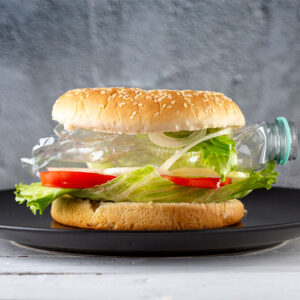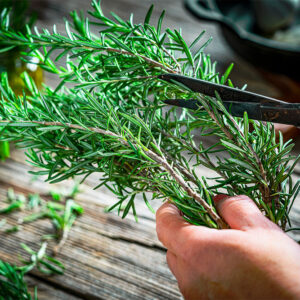
Solar-Powered Humans?
Every morning before work, I take a shot…
… of chlorophyll.
Yes, chlorophyll, the pigment found in plants that makes them so green and is responsible for converting sunlight into food.
I started doing this about five years ago when I realized the importance of maximizing phytonutrient intake, and I continue to do it because of the energy and skin benefits I get from it.
We’ve always known that green plants are good for us due to their vitamins, minerals, fiber, and phytonutrient content.
And I always assumed it was the micronutrients and phytonutrients in chlorophyll that helped increase my energy.
But I just stumbled upon a study that made me do a double take. The results from it indicated that chlorophyll may actually allow humans to harvest energy from the sun.
I’m not kidding!
Before we discover the details of this remarkable study, let’s take a refresher in Biology 101 and recall exactly how plants and animals produce energy.
In just about all life-forms, energy is stored in adenosine-5’-triphosphate (ATP) molecules. In humans and other animals, ATP is created in the mitochondria of our cells through the process of respiration. This process converts the nutrients we eat into cellular energy.
You probably recall hearing the mitochondria referred to as “the powerhouses” of the cell, because they are responsible for producing energy.
Plants, however, contain chlorophyll molecules that generate ATP by harvesting light.
OK, now on to the study.
First, researchers at the Columbia University Medical Center wanted to see if chlorophyll could actually get into mammalian cells. After feeding rats a chlorophyll-rich diet, they found that the rats had measureable levels of a metabolite of chlorophyll in their mitochondria. (1) This indicates that the plant pigments actually can get inside to the powerhouse of our cells.
Next, they fed the same chlorophyll metabolite to a group of special worms called C. elegans. The researchers were able to measure the ATP production of the worms and found that the group given the chlorophyll metabolite had a much greater increase in ATP production than the worms that did not. That means, the worms were actually able to create energy not with calories, but chlorophyll.
The chlorophyll metabolite also extended their life span.
The most striking thing about this study was that only when the worms fed chlorophyll were exposed to light was ATP production significant. When the chlorophyll metabolite-fed worms were in the dark, there was no increase in ATP.
In other words, the worms were able to harvest energy from light, just like plants.
And while this was in worms, C. elegans share many of the same essential biological characteristics as humans and are frequently used in scientific studies.
Other studies have confirmed this phenomenon and shown that mammalian cells are able to produce cellular energy directly through sun exposure. (2)
It does make me wonder…I always seem to have more energy in the summer even though I don’t eat as much food. Is the fact that we tend to eat ripe, chlorophyll-rich plants in the spring and summer months coupled with the ability to create energy from the sun the reason for this?
It’s interesting to consider.
But right now many of you are probably thinking: Well, that’s great and all, Jasmine, but HELLO! It’s WINTER! I’m not exactly able to go soak up the rays right now.
I hear you.
So is there any other reason to sling back shots of green juice every day, even during the winter?
Yup. Read on.
If you love grass-fed red meat as much as I do, you may want to consider taking a shot of chlorophyll (or eating some sautéed spinach) with your next steak or burger. That’s because chlorophyll could be crucial to help protect you against colon cancer.
According to the Linus Pauling Institute, chlorophyll is able to bind to certain carcinogens (like those found in cooked meat) and interfere with their absorption in the body. (3)
Chlorophyll and haem (a compound found in red meat) have similar molecular structures.
When eaten, haem is metabolized in the gut to a carcinogenic cytotoxic compound. This is why there has been an established association between red meat and colon cancer.
But in one animal study, when chlorophyll or chlorophyll-containing spinach was administered along with haem, they both completely inhibited the formation of the cytotoxic haem compound. (4)
So while there may be an association between red meat and colon cancer, there’s an even greater association between vegetables and protection against cancer. This may be one reason why.
If you don’t eat much red meat but you eat peanuts, legumes, or grains, you’ll want to consider this: Chlorophyll may also help protect against aflatoxin-induced liver cancer (5). Aflatoxin is a dangerous toxin commonly found on peanuts and moldy grains.
Regardless of exactly how they promote health, it undisputable that green, leafy plants and dark-colored fruits and vegetables are amazing for us and should form the basis of our daily diet.
And if you’ve ever done a shot of chlorophyll, juiced a bunch of green veggies, or mixed up a superfood drink mix that contains chlorophyll-rich ingredients, you know the amazing energy chlorophyll can give you.
While eating whole food is always best, if you want to significantly boost your daily intake of chlorophyll, you can buy it as a supplement and mix it in with your favorite drink or take it straight up in a shot glass.
I use World Organic Liquid Chlorophyll. Some brands (including this one) extract the chlorophyll from alfalfa, which has a genetically modified variety, so be sure to buy organic.
You can also look for a powdered superfood drink mix that includes ingredients like organic chlorella, organic kale, organic spinach, and organic parsley.
(One last tip: One researcher here at Living Well swears by chlorophyll to help cure a hangover. They shall remain unnamed.)
To living well,

Jasmine LeMaster
Health Researcher, Living Well
Sources
[1] Cheng X. Et al. Light-harvesting chlorophyll pigments enable mammalian mitochondria to capture photonic energy and produce ATP. J Cell Sci 2014 127: 388-399; doi: 10.1242/jcs.134262
[2] Herrera A.S. et al. Beyond mitochondria, what would be the energy source of the cell? Cent Nerv Syst Agents Med Chem. 2015;15(1):32-41. (PubMed)
[3] Dashwood R, Yamane S, Larsen R. Study of the forces of stabilizing complexes between chlorophylls and heterocyclic amine mutagens. Environ Mol Mutagen. 1996;27(3):211-218. (PubMed)
[4] De Vogel et al. Green vegetables, red meat and colon cancer: chlorophyll prevents the cytotoxic and hyperproliferative effects of haem in rat colon. Carcinogenesis. 2005 Feb;26(2):387-93. Epub 2004 Nov 18. (PubMed)
[5] Simonich MT, Egner PA, Roebuck BD, et al. Natural chlorophyll inhibits aflatoxin B1-induced multi-organ carcinogenesis in the rat. Carcinogenesis. 2007;28(6):1294-1302. (PubMed)
View More Free Articles
America’s Next Prescription Epidemic?
It started with a prescription to help you stay focused… But now, for millions of Americans, that little orange pill bottle could be a gateway to something much darker. According to a brand-new national study, one in four adults prescribed stimulants for ADHD is misusing them—and nearly one in 10 has developed a full-blown use...
Is Your Diet ACTUALLY Healthy? Here’s How to Tell
I’ve probably uttered the phrase “healthy diet” when talking to patients, family, and friends more times than I’ve had cups of coffee—and that’s saying something! But I’ll admit it’s not always entirely clear what a healthy diet looks like. What does healthy eating really mean? Let’s take a look… Good news—healthy eating doesn’t mean you...
7 Natural Ways to Tackle Pain Without Pills
On Tuesday, we explored a promising new frontier in pain relief: terpenes, natural compounds found in cannabis (and other plants) that may ease pain without the risks of opioids. That research is still developing. But what if you’re looking for help right now? Good news: You don’t have to wait for a pharmaceutical breakthrough to...
Mailbag: Pinched to Pain Free with Natural Sciatica Solutions
“I have been suffering from sciatic pain in my hip and groin. I try to do exercises to stretch it. But ever since I slipped on the ice and fell on my left hip it seems to be getting worse. Is there any help for this?” -Painfully Pinched Dear Pinched, I understand how frustrating sciatic...
New Cannabis Discovery Could Ease Pain—Without the High
A few years ago, everywhere you turned, someone was talking about CBD. The cannabis extract had exploded in popularity for everything from anxiety to inflammation to joint pain. And while the CBD conversation continues, another cannabis compound is quietly making headlines. One that could—believe it or not—provide relief from all kinds of pain. Without the...
"Sinful Trio" SLASHES Metabolic Syndrome Risk
Are you tired of hearing your doctor’s endless “don’t eat this, don’t drink that” lectures? Well, this Easter Sunday, I’ve got news that might just have you hopping happily to your pantry. Turns out, some of life’s tastiest pleasures could help protect you from one of today’s most common health threats—metabolic syndrome. Let’s dig into...
Microplastics’ Hidden Link to Chronic Disease EXPOSED
By now, you’ve heard about microplastics. These tiny fragments of plastic have invaded virtually every corner of our planet. We’re just beginning to understand the scope of the threat, but we know microplastics pose a serious risk to our health. If you’re like many folks, you’ve shrugged off those dangers, thinking there’s nothing you can...
Shakespeare’s “Remembrance” Herb Protects Memory
You probably have a jar of rosemary sitting in your spice rack. Perhaps you sprinkle it on potatoes or add it to roast chicken. But what if this humble herb could hold the key to fighting one of the most devastating diseases we can face as we age? It turns out a hidden compound inside...
Is Your Gut “Good”? How to Check
I always get asked, “How do I know if my digestion is working right?” Well, the answer is pretty simple, but it’s also a little gross. A simple test you can do at home reveals whether your digestion is normal or not. Your digestive system processes everything you eat—extracting nutrients, and eliminating waste. The time...
Hidden Sugar Trap Fuels Lung Cancer
We’ve long known that smoking is the main villain behind lung cancer. But what if your dinner plate has quietly joined forces with the enemy? A new study from the University of Florida reveals that the typical Western diet could be laying the groundwork for aggressive lung cancer growth by feeding tumors with stored sugar....









